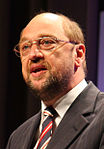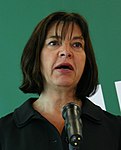European Parliament election, 2009 (Germany)
|
|
|||||||||||||||||||||||||||||||||||||||||||||||||||||||||||||||||||||||||||
|---|---|---|---|---|---|---|---|---|---|---|---|---|---|---|---|---|---|---|---|---|---|---|---|---|---|---|---|---|---|---|---|---|---|---|---|---|---|---|---|---|---|---|---|---|---|---|---|---|---|---|---|---|---|---|---|---|---|---|---|---|---|---|---|---|---|---|---|---|---|---|---|---|---|---|---|
|
|||||||||||||||||||||||||||||||||||||||||||||||||||||||||||||||||||||||||||
|
All 99 German seats in the European Parliament |
|||||||||||||||||||||||||||||||||||||||||||||||||||||||||||||||||||||||||||
| Opinion polls | |||||||||||||||||||||||||||||||||||||||||||||||||||||||||||||||||||||||||||
| Turnout | 43.3% | ||||||||||||||||||||||||||||||||||||||||||||||||||||||||||||||||||||||||||
|
|||||||||||||||||||||||||||||||||||||||||||||||||||||||||||||||||||||||||||
The European Parliament election of 2009 in Germany was the German part of the European Parliament election, 2009. The voting was held on Sunday, 7 June. A total of 26 parties competed for the 99 seats reserved for Germany in the European Parliament. In the previous election of 2004, the six parties which were represented in the German national parliament (Bundestag) from 2005 to 2013, had entered the European Parliament by overcoming the 5% election threshold. The same parties entered the European Parliament this time. None of the other parties managed to gain more than 1.7%, but together the small parties exceeded 10% for the first time. At 43.3%, the voter turnout was just over the all-time low in the previous European election in Germany (43.0%).
From the 2004 European elections, the CDU had emerged as the strongest party vote, together with the CSU had achieved 44.5% of the vote and 49 of the 99 German mandates. In contrast, the SPD lost heavily and only came to 23 seats (21.5% of the vote). Third strongest party were the Greens with 13 seats (11.9%), followed by PDS (Party of the predecessor left ) and the FDP with 7 seats (6.1%). Since the turnout in European elections is traditionally low, some significant differences can be attributed (e.g. in federal elections) including the respective importance generally attributed to the various constituencies parties European elections of the results at national level.
The 2009 European elections fell in Germany in the pre-election campaign for the 2009 election . It was therefore often regarded as a "test vote" for this, in which the various parties first position and, for example, could test the response to specific campaign issues.
In the media, however, the European elections was initially compared with other events, such as the election of the President 23 May 2009, rather little present; and the election campaign of the parties was rather unspectacular. Attention was a campaign of SPD in which these slogans as would choose FDP financial sharks or hot air would choose the Left parties other attack directly. Although there are some historical examples (such as the Red Sock Campaign of the CDU 1994), this form of negative campaigning is otherwise rather unusual in elections in Germany.
Legal basis for the European elections in Germany is the European Elections Act, which in many areas of the Federal Electoral Act refers. The choice is a proportional representation, that is, each party gets seats in proportion to their share of the nationwide valid votes allocated. However, only parties were considered, at least nationwide five percent of the valid votes reached. (The five-percent hurdle in 2011 was declared unconstitutional in retrospect, but this did not lead to a redistribution of seats. The 2014 European elections took place in Germany without a restrictive clause.)
...
Wikipedia





